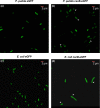Metabolic engineering to expand the substrate spectrum of Pseudomonas putida toward sucrose
- PMID: 28349670
- PMCID: PMC5552902
- DOI: 10.1002/mbo3.473
Metabolic engineering to expand the substrate spectrum of Pseudomonas putida toward sucrose
Abstract
Sucrose is an important disaccharide used as a substrate in many industrial applications. It is a major component of molasses, a cheap by-product of the sugar industry. Unfortunately, not all industrially relevant organisms, among them Pseudomonas putida, are capable of metabolizing sucrose. We chose a metabolic engineering approach to circumvent this blockage and equip P. putida with the activities necessary to consume sucrose. Therefore, we constructed a pair of broad-host range mini-transposons (pSST - sucrose splitting transposon), carrying either cscA, encoding an invertase able to split sucrose into glucose and fructose, or additionally cscB, encoding a sucrose permease. Introduction of cscA was sufficient to convey sucrose consumption and the additional presence of cscB had no further effect, though the sucrose permease was built and localized to the membrane. Sucrose was split extracellularly by the activity of the invertase CscA leaking out of the cell. The transposons were also used to confer sucrose consumption to Cupriavidus necator. Interestingly, in this strain, CscB acted as a glucose transporter, such that C. necator also gained the ability to grow on glucose. Thus, the pSST transposons are functional tools to extend the substrate spectrum of Gram-negative bacterial strains toward sucrose.
Keywords: Pseudomonas putida; metabolic engineering; sucrose metabolism.
© 2017 The Authors. MicrobiologyOpen published by John Wiley & Sons Ltd.
Figures






Similar articles
-
Polyhydroxyalkanoate production from sucrose by Cupriavidus necator strains harboring csc genes from Escherichia coli W.Appl Microbiol Biotechnol. 2017 Oct;101(20):7497-7507. doi: 10.1007/s00253-017-8470-7. Epub 2017 Sep 9. Appl Microbiol Biotechnol. 2017. PMID: 28889198
-
Engineering sucrose metabolism in Pseudomonas putida highlights the importance of porins.Microb Biotechnol. 2020 Jan;13(1):97-106. doi: 10.1111/1751-7915.13283. Epub 2018 May 28. Microb Biotechnol. 2020. PMID: 29808622 Free PMC article.
-
Substrate utilization by recombinant Yarrowia lipolytica growing on sucrose.Appl Microbiol Biotechnol. 2012 Feb;93(4):1695-702. doi: 10.1007/s00253-011-3681-9. Epub 2011 Nov 12. Appl Microbiol Biotechnol. 2012. PMID: 22080330
-
Pseudomonas putida as a functional chassis for industrial biocatalysis: From native biochemistry to trans-metabolism.Metab Eng. 2018 Nov;50:142-155. doi: 10.1016/j.ymben.2018.05.005. Epub 2018 May 16. Metab Eng. 2018. PMID: 29758287 Review.
-
Industrial biotechnology of Pseudomonas putida and related species.Appl Microbiol Biotechnol. 2012 Mar;93(6):2279-90. doi: 10.1007/s00253-012-3928-0. Epub 2012 Feb 18. Appl Microbiol Biotechnol. 2012. PMID: 22350258 Review.
Cited by
-
An automated and parallelised DIY-dosing unit for individual and complex feeding profiles: Construction, validation and applications.PLoS One. 2019 Jun 19;14(6):e0217268. doi: 10.1371/journal.pone.0217268. eCollection 2019. PLoS One. 2019. PMID: 31216302 Free PMC article.
-
Industrial biotechnology of Pseudomonas putida: advances and prospects.Appl Microbiol Biotechnol. 2020 Sep;104(18):7745-7766. doi: 10.1007/s00253-020-10811-9. Epub 2020 Aug 13. Appl Microbiol Biotechnol. 2020. PMID: 32789744 Free PMC article. Review.
-
Biotransformation of 2,4-dinitrotoluene in a phototrophic co-culture of engineered Synechococcus elongatus and Pseudomonas putida.Microb Biotechnol. 2020 Jul;13(4):997-1011. doi: 10.1111/1751-7915.13544. Epub 2020 Feb 16. Microb Biotechnol. 2020. PMID: 32064751 Free PMC article.
-
Photoautotrophic production of polyhydroxyalkanoates in a synthetic mixed culture of Synechococcus elongatus cscB and Pseudomonas putida cscAB.Biotechnol Biofuels. 2017 Jul 19;10:190. doi: 10.1186/s13068-017-0875-0. eCollection 2017. Biotechnol Biofuels. 2017. PMID: 28814973 Free PMC article.
-
Developing Bioprospecting Strategies for Bioplastics Through the Large-Scale Mining of Microbial Genomes.Front Microbiol. 2021 Jul 12;12:697309. doi: 10.3389/fmicb.2021.697309. eCollection 2021. Front Microbiol. 2021. PMID: 34322108 Free PMC article.
References
-
- Aparicio, T. , Jensen, S. I. , Nielsen, A. T. , de Lorenzo, V. , & Martínez‐García, E. (2016). The Ssr protein (T1E_1405) from Pseudomonas putida DOT‐T1E enables oligonucleotide‐based recombineering in platform strain P. putida EM42. Biotechnology Journal, 11, 1309–1319. - PubMed
-
- Belda, E. , van Heck, R. G. A. , Lopez‐Sanchez, M. J. , Cruveiller, S. , Barbe, V. , Fraser, C. , … Médigue, C. (2016). The revisited genome of Pseudomonas putida KT2440 enlightens its value as a robust metabolic chassis. Environmental Microbiology, 18, 3403–3424. - PubMed
-
- Chen, G.‐Q. (2009). A microbial polyhydroxyalkanoates (PHA) based bio‐ and materials industry. Chemical Society Reviews, 38, 2434–2446. - PubMed
-
- de Lorenzo, V. , Eltis, L. , Kessler, B. , & Timmis, K. (1993). Analysis of Pseudomonas gene products using lacIq/Ptrp‐lac plasmids and transposons that confer conditional phenotypes. Gene, 123, 17–24. - PubMed
-
- de Lorenzo, V. , & Timmis, K. (1994). Analysis and construction of stable phenotypes in gram‐negative bacteria with Tn5‐ and Tn10‐derived minitransposons. Methods in Enzymology, 235, 386–405. - PubMed
MeSH terms
Substances
LinkOut - more resources
Full Text Sources
Other Literature Sources
Molecular Biology Databases

